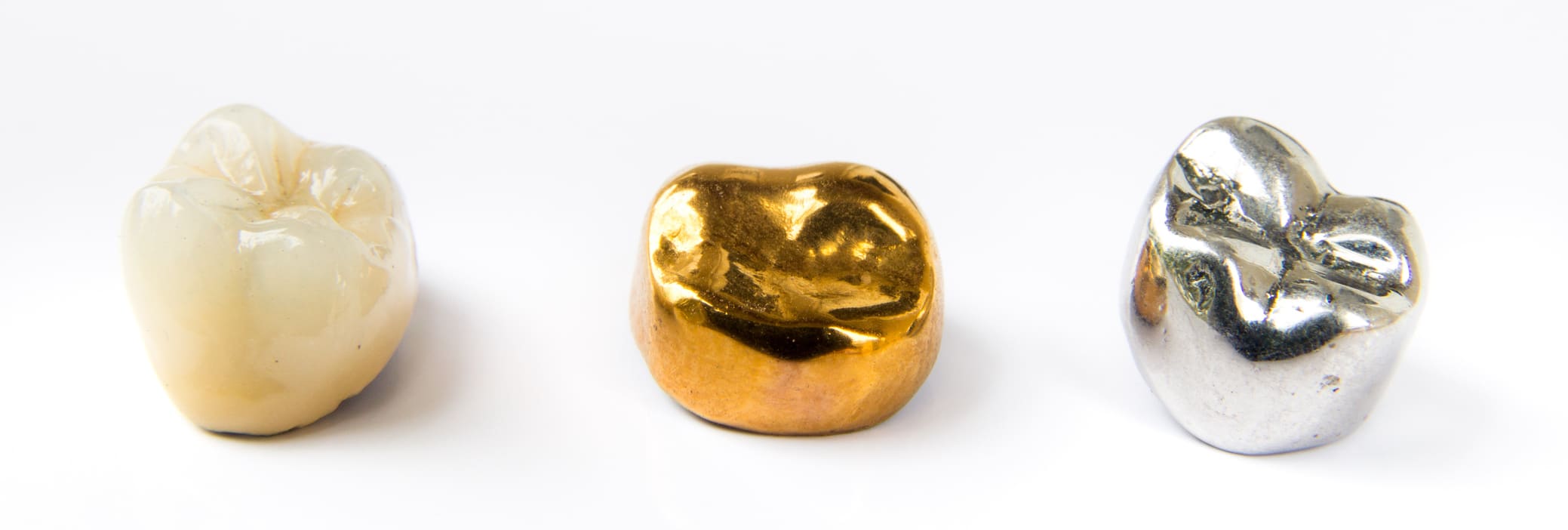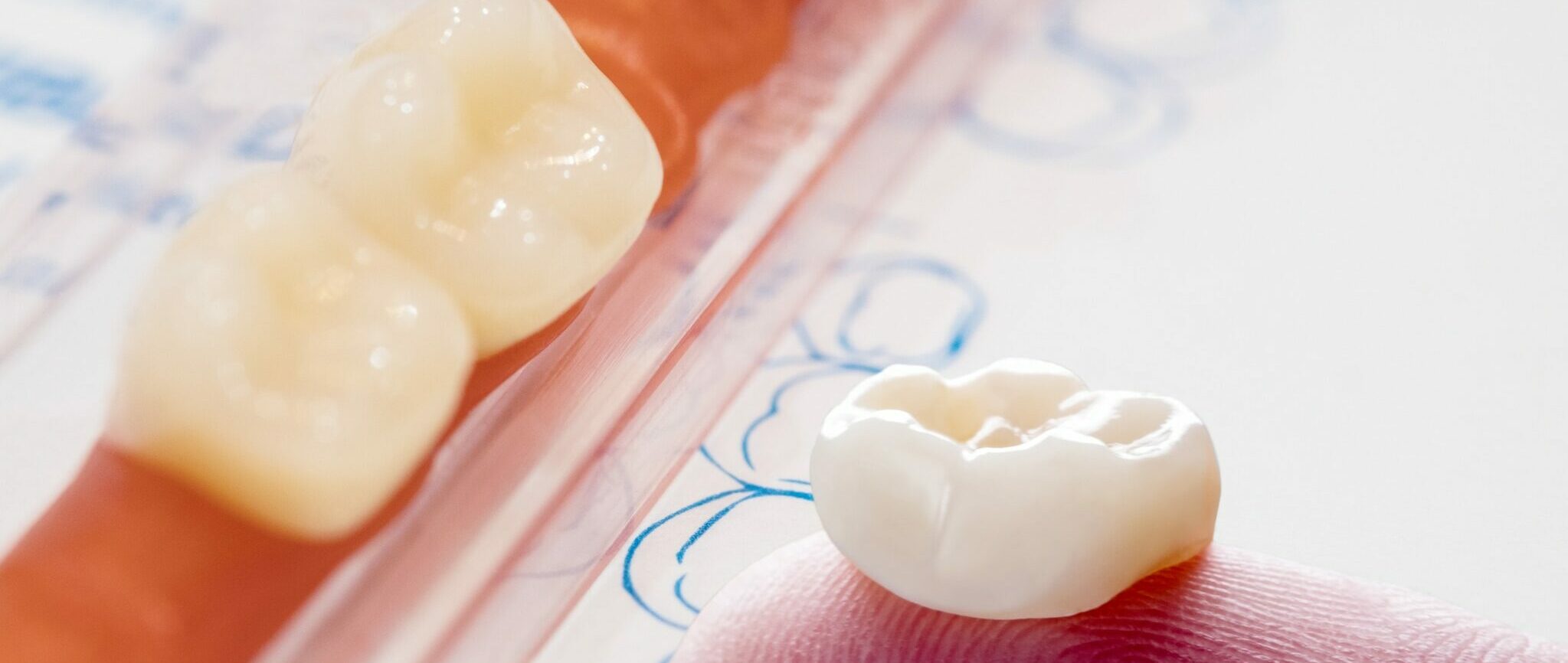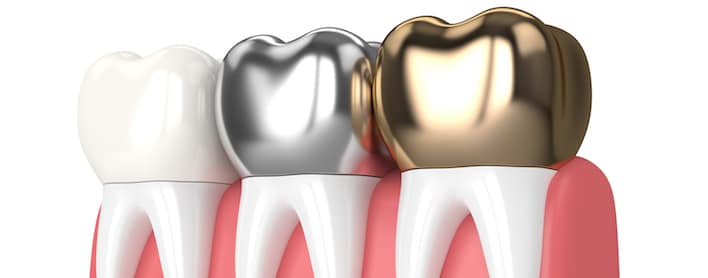When it comes to crowns, choosing the right dental crown material is key to ensuring the longevity, function, and aesthetics of your restoration. Among the most common materials are Porcelain-Fused-to-Metal (PFM), Zirconia (including full zirconia, layered zirconia, and high-translucency zirconia), and Emax crowns, due to their natural appearance, but there are a variety of natural and metal options to choose from. Each of these materials offers unique benefits, with some being considered upgraded options that may come at a higher cost. Let’s explore the differences to help you understand the available options.

Porcelain-Fused-to-Metal (PFM) Crowns
PFM crowns have been the go-to choice for many years, offering a solid combination of strength and aesthetics. They consist of a metal base, which is covered by a layer of porcelain. The metal used for these crowns can be base metal alloys (nickel, cobalt or chromium), titanium alloys, or gold alloys. For PFM crowns, base metals are typically selected for cost effectiveness, but these can sometimes trigger metal allergies for some people, so it’s critical to know whether or not you have sensitivity to certain alloys.
PFM Crown Strengths:
- Durability: The metal core provides exceptional strength, making these crowns a reliable option, especially for back teeth that endure heavy biting forces.
- Cost-Effective: As the base crown material, PFM is generally the least expensive option, making it accessible for patients on a budget.
PFM Crown Drawbacks:
- Aesthetics:
- Visible Metal Line: The metal core can sometimes cause a visible dark line at the gum line, especially if the gums recede over time. This dark line is noticeable in areas where the gum is thin or where the crown meets the tooth.
- Opaque Porcelain: The porcelain layer on PFM crowns can be more opaque compared to other materials, which might not blend as seamlessly with natural teeth. This can result in a less natural appearance, particularly in the front teeth.
- Gum Health Impact: Over time, the metal base may affect the health of the surrounding gum tissue, potentially leading to visible darkening or a metal line if the gums recede.
- Wear on Opposing Teeth: The hardness of the porcelain can lead to increased wear on the opposing teeth, which might require additional dental work over time.
- Porcelain Chipping: The porcelain layer can sometimes chip or crack, particularly under heavy biting forces or if the patient has a habit of grinding teeth.
- Allergic Reactions: In rare cases, patients may experience allergic reactions to the metal used in PFM crowns, leading to discomfort or other issues.
- Temperature Sensitivity: PFM crowns can sometimes cause temperature sensitivity, as the metal may conduct hot and cold temperatures more than other materials.
If you’re looking for dental crowns in Las Vegas, visit a BDG dentist for quality, affordable crown options from highly trained dentists. Schedule a consultation today at one of our 14+ locations across Las Vegas, Henderson and Laughlin, Nevada ›
Zirconia Crowns
Zirconia crowns have gained popularity due to their remarkable strength and aesthetic versatility. Doctors generally determine which type of zirconia crown based on the location of the tooth. We offer full zirconia crowns as well as layered or highly translucent options, depending on their preference and the aesthetics. Each type of zirconia crown delivers a unique set of benefits, which we will break down in detail below.
Full Zirconia Crowns:
- Strength: Full zirconia crowns are extremely strong, making them ideal for patients with heavy bite forces or those who grind their teeth.
- Longevity: These crowns are resistant to chipping and cracking, ensuring a long-lasting restoration.
- Aesthetics: While durable, full zirconia crowns are less translucent, so they may not be the first choice for front teeth where appearance is a primary concern.
Layered Zirconia Crowns (Upgrade):
- Aesthetic Appeal: These crowns combine a strong zirconia core with a porcelain exterior, offering both durability and a more natural appearance.
- Customization: Layered zirconia allows for detailed color matching and translucency, making them suitable for highly visible teeth.
High-Translucency Zirconia Crowns (Upgrade):
- Natural Look: High-translucency zirconia closely mimics the natural translucency of real teeth, providing an excellent balance between strength and aesthetics.
- Versatility: These crowns are versatile and can be used for both front and back teeth, offering a natural look without compromising durability.
Zirconia Crown Drawbacks:
- Cost: Zirconia crowns are an upgraded material option and the high level of durability and natural aesthetics often comes at a higher price point than other materials.
- Difficult Future Adjustments: Because zirconia crowns bond so well to natural tooth structures, in some cases this can make future adjustments or modifications more difficult once the crowns are placed.
Emax Crowns (Upgrade)
Emax crowns, made from lithium disilicate glass-ceramic, are known for their exceptional aesthetics and sufficient strength. They are often chosen for front teeth due to their lifelike appearance.
Emax Crown Strengths:
- Aesthetics: Emax crowns are highly translucent, closely resembling natural enamel, making them ideal for patients seeking a natural-looking smile.
- Less Tooth Removal: These crowns require less tooth reduction, preserving more of the natural tooth structure during preparation.
- Versatility: Emax is suitable for various types of restorations, including veneers, inlays, onlays, and crowns.
Emax Crown Drawbacks:
- Strength Limitation: While strong, Emax crowns may not be as durable as zirconia crowns, especially for patients with heavy bite forces.
- Cost: Emax crowns are generally more expensive, reflecting their premium quality and aesthetic appeal.
PFG, Gold, and Stainless Steel Crowns
The following crown types are less commonly selected, but are available for children, and adults who may have sensitivities to certain materials, would like a durable solution for a lower cost, or have particular aesthetic preferences.
Porcelain-Fused-to-Gold (PFG) Crowns:
PFG crowns are similar to PFM crowns but use gold as the underlying material. This is often a good solution for people who would prefer a porcelain-fused-to-metal crown, but experience sensitivities with other metals and metal alloys.
- Strengths: Gold is highly biocompatible, reducing the risk of allergic reactions, and provides a better fit due to its malleability.
- Aesthetics: Like PFM, PFG crowns can have a visible line at the gum line, but the gold may be more aesthetically pleasing than other metals.
- This upgraded crown is not included in promotion
Gold Crowns:
Gold crowns are made entirely of gold or a gold alloy, known for their unmatched durability. For people who bite heavily or grind their teeth, gold is a great option as it can withstand more pressure than other materials.
- Strengths: Gold crowns are resistant to chipping or breaking, gentle on opposing teeth, and require less tooth structure removal. Gold crowns also very rarely need to be replaced.
- Drawbacks: Their metallic color doesn’t blend with natural teeth, making them more suitable for back teeth.
- This upgraded crown is not included in promotion
Stainless Steel Crowns:
Stainless steel crowns are often used for children’s teeth as a temporary solution. They are durable, cost-effective, and relatively easy to place, making them a practical option until the child’s permanent teeth come in. In most cases, adults do not get stainless steel crowns unless they have medical conditions that make them necessary or they are used as a temporary option until a different material can be placed. One potential drawback of stainless steel crowns is that some people may react to the nickel that they contain, though in most cases the stainless steel used today does not trigger allergic reactions.
Consulting Your Dentist for the Best Choice for Dental Crowns
Ultimately, the best crown material for you will depend on various factors, including the location of the tooth, your bite force, aesthetic preferences, and budget. While PFM crowns offer a cost-effective base option, zirconia and Emax crowns are often considered upgraded materials, providing enhanced aesthetics and durability at a higher cost.
Your dentist will assess your specific needs and recommend the most appropriate crown material, ensuring a restoration that meets both your functional and aesthetic goals.



